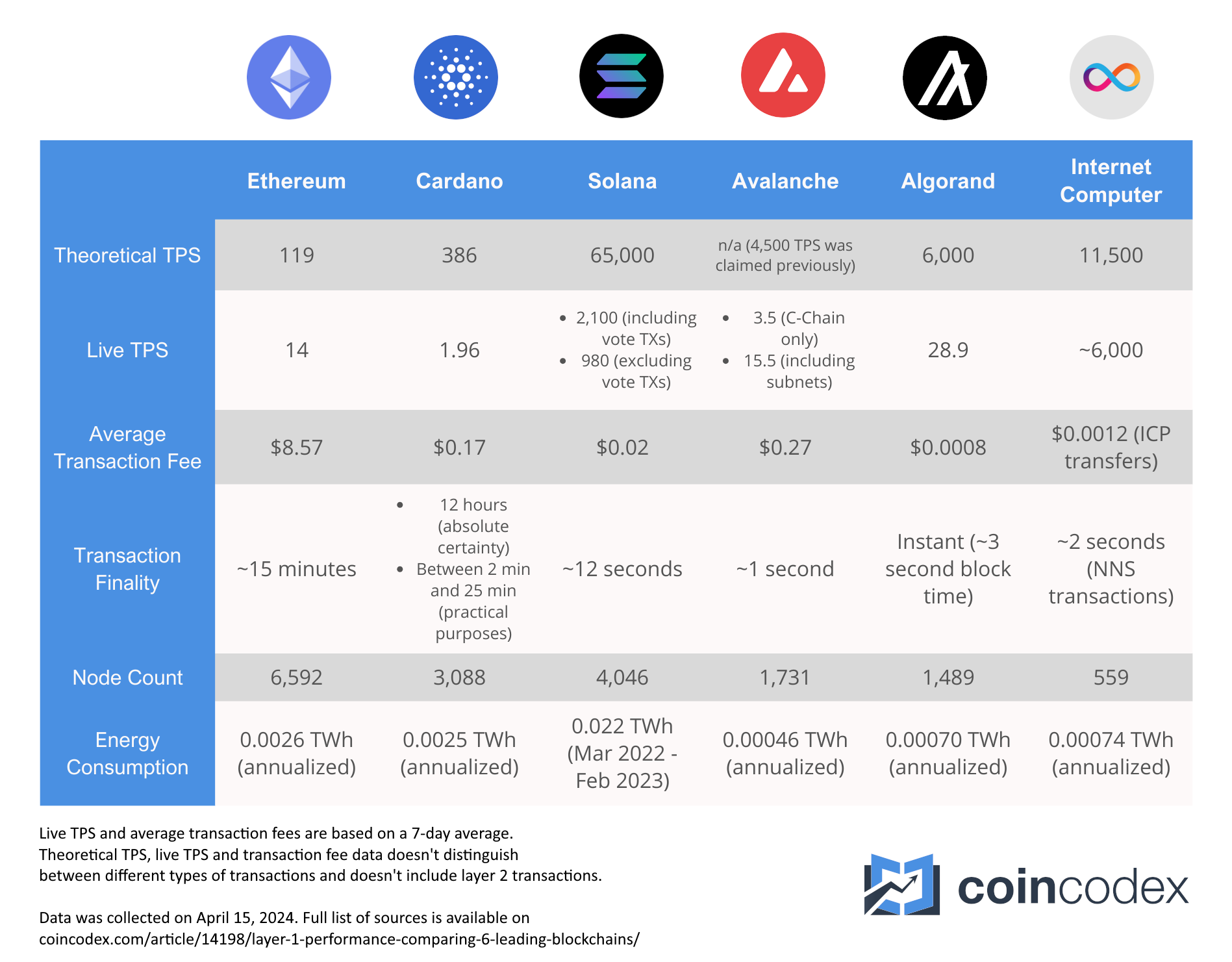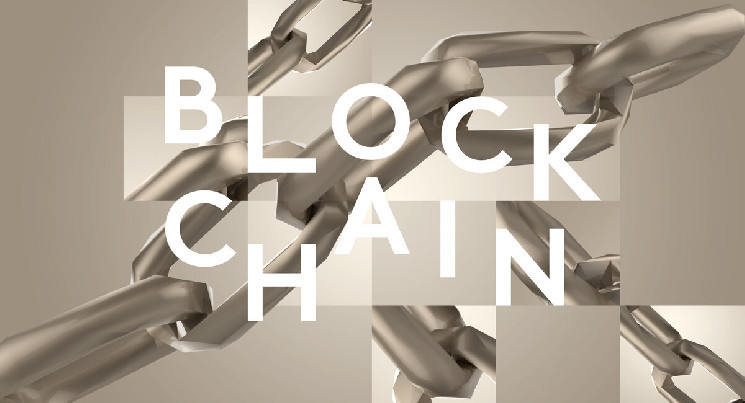We provide a layer 1 blockchain performance comparison of 6 major blockchain platforms: Ethereum, Cardano, Solana, Avalanche, Algorand and Internet Computer.
Before we start our comparison, it is important to emphasize that scaling at layer 1 is not the only way to improve the scalability of blockchains. Projects like Ethereum and Cardano are paying close attention to scaling through layer 2 solutions that can handle a larger number of transactions while leveraging the security of the underlying layer 1.
In this article we’ve limited the comparisons to tier 1 performance, but it’s worth keeping in mind that this doesn’t tell the whole story. For example, Ethereum users already benefit significantly from layer 2 solutions such as Arbitrum, Optimism and Base. and layer 2 technologies are steadily improving and gaining acceptance.
At the bottom of the article we provide a full list of sources used to make this comparison.

Comparison of the layer 1 performance of 6 major blockchains
The simplest way to compare the performance of blockchains is to see how many transactions a blockchain can process within a certain period of time. The most commonly used metric for this purpose is TPS (transactions per second).
Another important aspect to consider is the time it takes for a blockchain to become final. This metric refers to how long it takes for a transaction to be considered irreversible on the blockchain. There’s a lot of nuance to the topic of blockchain finality (in many blockchains what’s considered “final” is up to interpretation), but we’ve done our best to find generally accepted figures on time to finality for each of the blockchains . we compare.
Ethereum
Ethereum can theoretically handle 119 TPS at layer 1, although it is unlikely that the network will ever approach this number as it would require a very specific set of conditions (for example, all transactions are standard ETH transfers).
In practice, the Ethereum network processes approximately 14 transactions per second at layer 1. The demand for transactions on the Ethereum blockchain is enormous – according to cryptofees.info, Ethereum users currently pay approximately $9.6 million in total fees every day.
Ethereum transactions are considered final after a period of approximately 15 minutes, which corresponds to 2 epochs (an epoch is a period of 32 slots during which validators propose blocks and confirm blocks). Ethereum’s roadmap includes a concept called Single Slot Finality (SSF), which would reduce the time to finality to just a few seconds.
Cardano
Cardano’s current theoretical TPS limit is around 386 TPS. The Cardano blockchain is averaging around 2 TPS at the time of writing this article, although there is quite a bit of headroom to accommodate a spike in transaction demand.
The Cardano project is also working on several solutions, such as sidechains and layer 2s, to dramatically improve scalability. Probably the most notable development here is the Hydra Layer 2 scalability solution.
When it comes to Cardano’s time to finality, there is quite a bit of nuance. The Ouroboros Proof-of-Stake consensus protocol guarantees finality after 2,160 blocks, which takes approximately 12 hours.
However, in most practical scenarios, this degree of finality is not required before a transaction can be considered settled. In practical scenarios, Cardano transactions can be considered final between 2 and 25 minutes. The length of time to wait before a transaction is considered final ultimately depends on the significance of the transaction to the parties executing it.
Solana
Solana is a blockchain project that mainly focuses on layer 1 improvements to increase scalability. Solana is already performing very well compared to most other blockchains on the market today. Under test conditions, Solana has shown that it can process approximately 65,000 transactions per second.
Currently, the Solana blockchain processes an average of just over 2,000 transactions per second. However, this statistic also includes voting transactions, which some may not consider “real” transactions. If we ignore these transactions, Solana processes an average of just under 1,000 transactions per second in real conditions.
In terms of scalability improvements, the Solana community is looking forward to the upcoming mainnet launch of Firedancer, a high-performance Solana client being developed by Jump Crypto. Because of its efficiency, Firedancer is poised to make Solana even faster and more cost-efficient as a layer 1 blockchain.
On Solana, transactions are considered final after 31 block confirmations, which typically takes about 12 seconds.
Avalanche
We were previously able to find claims of 4,500 theoretical TPS on various materials on the official Avalanche website, but the project no longer appears to claim 4,500 theoretical TPS in its official materials. As of April 2024, we couldn’t find a good benchmark for the number of transactions Avalanche can theoretically handle.
Moving on to practice, Avalanche currently processes around 3.5 TPS if we count only the C-Chain, the chain in the Avalanche network that is in charge of handling EVM-compatible smart contracts. If we also include Avalanche’s various subnets in the comparison, the Avalanche network processes approximately 15.5 transactions per second.
Avalanche’s Proof-of-Stake consensus protocol excels in terms of time to finality, as trades on Avalanche reach finality in approximately one second.
Algorand
The Algorand blockchain can theoretically handle around 6,000 TPS after the 3.9 upgrade, which increased the block size to 5 MiB and reduced block latency to less than 4 seconds. The project claims that it has a key performance goal: achieving 10,000 TPS, which will be achieved primarily by reducing lap times.
In practice, the Algorand blockchain processes just under 30 transactions per second, with users paying an average of only about $0.0008 in fees per transaction.
The design of the Algorand blockchain makes it possible to achieve “instant” finality, although in practice this is limited by the block time. Currently, Algorand adds blocks to the chain approximately every 3 seconds, which can be considered the time to finality of a transaction on Algorand.
Similar to Solana, the Algorand project’s scalability roadmap focuses primarily on layer 1 improvements rather than relying on layer 2 scalability solutions.
Internet computer
In its current configuration, the Internet computing platform can theoretically handle approximately 11,500 TPS. In practice, at the time of writing this article, the Internet computer is processing approximately 6,000 TPS.
Internet computing platform transactions have fast finality – subnets dedicated to decentralized applications can reach finality in about 1 second, while finality for NNS (Network Nervous System) transactions is about 2 seconds.
Although costs on the network vary depending on the action the user is trying to perform, sending the network’s own ICP only costs about $0.0012 on average.
While the Internet Computer offers impressive scalability compared to most blockchains, it is important to keep in mind that the Internet Computer makes quite a few tradeoffs between decentralization and performance. For example, joining the network as a validator requires permission. Meanwhile, all the other blockchains we mentioned in this article are permissionless.
it comes down to
Our goal was to provide a basic comparison between leading blockchains and not to determine which blockchain is the “best”. Hopefully our layer 1 blockchain performance comparison has helped you decide which L1 network is best for your needs. Although scaling is a very complex topic, we focused on characteristics such as transaction speed, finality, scalability, number of nodes, and energy efficiency, which are among the most common metrics used to measure blockchain performance.
It is important to understand that different blockchains are designed with an emphasis on different features, so direct comparisons between chains should not be done without context.
For example, if a blockchain sacrifices some decentralization to increase transaction throughput, it would be unfair to label it “better” or “worse” than a blockchain that is more decentralized but not as performant.
Ultimately, it will be interesting to look beyond the performance metrics to see what the future holds for each of the blockchain networks discussed above.
In the meantime, you can check out our selection of the cheapest cryptocurrency networks for transfers, which will help you save on transaction fees and use DeFi and NFT products and services at an affordable cost.
Sources
Here are the sources we used to arrive at the data points used in our blockchain layer 1 performance comparison.
Ethereum
- Theoretical TPS: https://www.kiln.fi/post/path-to-proto-danksharding-episode-i-ethereum-scalability-limitations
- Live TPS: https://chainspect.app/chain/ethereum?range=7d
- Average transaction costs:
- https://www.theblock.co/data/on-chain-metrics/ethereum/average-transaction-fee-on-ethereum
- Finality: https://ethereum.org/en/roadmap/single-slot-finality/
- Ethernodes: https://www.ethernodes.org/
- Energy efficiency: https://ethereum.org/en/energy-consumption/
Cardano
- Theoretical TPS: https://eutxo.org/stats/records
- Live TPS: https://cexplorer.io/tps
- Average transaction costs: https://messari.io/project/cardano/charts/fees-and-revenue/chart/txn-fee-avg-ntv
- Energy efficiency: https://cexplorer.io/energy
- Finality of the transaction: https://twitter.com/_KtorZ_/status/1482346836992180224
- https://cexplorer.io/article/understanding-transaction-finality
- Number of nodes: https://adapools.org/
Solana
- Theoretical TPS: https://solana.com/news/network-performance-report-july-2023
- Live TPS: https://chainspect.app/chain/solana?range=7d
- Average transaction costs: https://solanacompass.com/statistics/fees
- Finality of the transaction: https://www.tbstat.com/wp/uploads/2022/02/20220222_FinalityReport_TheBlockResearch.pdf
- Number of nodes: https://solanacompass.com/statistics/decentralization
- Energy consumption: https://solanaclimate.com/
Avalanche
- Live TPS: https://snowtrace.io/chart/tps
- Average transaction costs: https://dune.com/queries/1389077/2361423
- Finality of the transaction: https://www.avax.network/blog/time-to-finality-ttf-the-ultimate-metric-for-blockchain-speed
- Number of nodes: https://subnets.avax.network/
- Energy consumption: https://www.avax.network/blog/ccri-report-2023
Algorand
- Theoretical TPS: https://developer.algorand.org/articles/algorand-boosts-performance-5x-in-latest-upgrade/
- Live TPS, average transaction costs: https://metrics.algorand.org/#/protocol/#transactions
- Finality of the transaction: https://metrics.algorand.org/#/protocol/#blocks
- Number of nodes: https://metrics.algorand.org/
- Energy consumption: https://twitter.com/JohnAlanWoods/status/1628781089853415424
Internet computer
- Theoretical TPS: https://medium.com/dfinity/the-internet-computers-transaction-speed-and-finality-outpace-other-l1-blockchains-8e7d25e4b2ef
- Live TPS, average transaction costs: https://dashboard.internetcomputer.org/
- Number of nodes: https://www.icpexplorer.org/#/datacenters
- Finality of the transaction: https://internetcomputer.org/docs/current/developer-docs/multi-chain/faq/cketh-faq
- Energy consumption: https://medium.com/dfinity/internet-computer-footprint-assessing-ic-energy-consumption-and-sustainability-4a4dcf10707a

